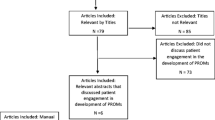Abstract
Purpose
To investigate relevant patient-reported outcome (PRO) domains for oncology clinical practice.
Methods
We conducted cross-sectional semi-structured telephone interviews with patients with breast and prostate cancer and clinicians. Using open-ended questions followed by structured prompts of PRO domains, subjects were asked what they currently discuss during visits and which topics are relevant for a clinical practice PRO. For each domain, we calculated the percentage of patients and clinicians who responded positively. A qualitative thematic content analysis identified barriers and benefits of using PROs in clinical practice.
Results
A total of 41 patients (21 breast cancer and 20 prostate cancer) and 15 clinicians (7 medical oncologists, 5 radiation oncologists, and 3 surgeons) completed the interviews. In general, clinicians and patients reported that the topics explored were relevant. Barriers to using PROs in clinical practice include (1) time constraints, (2) varying relevance of questions, (3) value of the conversational approach, (4) decreased usefulness in established relationships, and (5) respondent burden. Benefits of PROs in clinical practice include (1) identifying problems, (2) serving as a reminder of topics to discuss, and (3) tracking changes over time.
Conclusions
PROs in clinical practice may help triage issues and focus discussions. Computer-adaptive tests should be explored to tailor questionnaires to patients’ specific issues.






Similar content being viewed by others
Abbreviations
- CAT:
-
Computer-adaptive test
- PRO:
-
Patient-reported outcome
References
Epstein, R. M., & Street, R. L. (2007). Patient-centered communication in cancer care: Promoting healing and reducing suffering. National Cancer Institute, NIH Publication No. 07–6225. Maryland: Bethesda.
Institute of Medicine. (2001). Crossing the quality chasm: A new health system for the 21st century. Washington, DC: National Academy Press.
Donaldson, M. (2009). Taking PROs and patient-centered care seriously: Incremental and disruptive ideas for incorporating PROs in oncology practice. Quality of Life Research, 17, 1323–1330.
Greenhalgh, J., Long, A. F., & Flynn, R. (2005). The use of patient-reported outcome measures in routine clinical practice: Lack of impact or lack of theory? Social Science and Medicine, 60, 833–843.
Rose, M., & Bezjak, A. (2009). Logistics of collecting patient-reported outcomes (PROs) in clinical practice: An overview and practical examples. Quality of Life Research, 18, 125–136.
McHorney, C. A., & Tarlov, A. R. (1995). Individual patient monitoring in clinical practice: Are available health status surveys adequate? Quality of Life Research, 4, 293–307.
Snyder, C. F., Dy, S. M., Hendricks, D. E., et al. (2007). Asking the right questions: Investigating needs assessments and health-related quality of life questionnaires for use in oncology clinical practice. Supportive Care in Cancer, 15, 1075–1085.
Velikova, G., Awad, N., Coles-Gale, R., Wright, E. P., Brown, J. M., & Selby, P. J. (2008). The clinical value of quality of life assessment in oncology practice–a qualitative study of patient and physician views. Psycho-Oncology, 17, 690–698.
Hambleton, R. (2005). Applications of item response theory to improve health outcomes assessment: Developing item banks, linking instruments, and computer adaptive testing. In J. Lipscomb, C. C. Gotay, & C. Snyder (Eds.), Outcomes assessment in cancer: Measures, methods, and applications (pp. 445–464). New York: Cambridge University Press.
National Institutes of Health. Patient-reported outcomes measurement information system (PROMIS). http://www.nihpromis.org. Accessed 24 September 2009.
Detmar, S. B., Aaronson, N. K., Wever, L. D. V., Muller, M., & Schornagel, J. H. (2000). How are you feeling? Who wants to know? Patients’ and oncologists’ preferences for discussing health-related quality of life issues. Journal of Clinical Oncology, 18, 3295–3301.
Hilarius, D. L., Kloeg, P. H. A. M., Detmar, S. B., Muller, M. J., & Aaronson, N. K. (2007). Level of agreement between patient self-report and observer ratings of health-related quality of life communication in oncology. Patient Education and Counseling, 65, 95–100.
Acknowledgments
This research was supported by a Mentored Research Scholar Grant from the American Cancer Society (MRSG-08-011-01-CPPB; PI: Snyder). We appreciate the participation of the clinicians and patients in this study, with special thanks to the clinicians who assisted us with recruiting their patients.
Author information
Authors and Affiliations
Corresponding author
Rights and permissions
About this article
Cite this article
Snyder, C.F., Jensen, R.E., Geller, G. et al. Relevant content for a patient-reported outcomes questionnaire for use in oncology clinical practice: Putting doctors and patients on the same page. Qual Life Res 19, 1045–1055 (2010). https://doi.org/10.1007/s11136-010-9655-z
Accepted:
Published:
Issue Date:
DOI: https://doi.org/10.1007/s11136-010-9655-z




